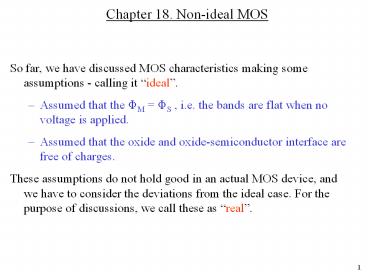Chapter 18. Nonideal MOS PowerPoint PPT Presentation
1 / 12
Title: Chapter 18. Nonideal MOS
1
Chapter 18. Non-ideal MOS
- So far, we have discussed MOS characteristics
making some assumptions - calling it ideal. - Assumed that the ?M ?S , i.e. the bands are
flat when no voltage is applied. - Assumed that the oxide and oxide-semiconductor
interface are free of charges. - These assumptions do not hold good in an actual
MOS device, and we have to consider the
deviations from the ideal case. For the purpose
of discussions, we call these as real.
2
Metal-semiconductor work function difference -
ideal
When ?M ?S , the Fermi level is aligned before
we make the device. So, when the MOS structure is
made, the band remains flat when the applied gate
voltage is zero.
Assumption ?MS ?M ?S 0
?S
?
?M
Flat band condition
EFS
EFM
O
M
S
3
Metal-semiconductor work function difference -
real
?M depends on the metal. Example ?M (Al) ? 4 eV,
?M (Au) ? 5.1 eV
?S depends on the semiconductor doping. ?S ?
(EC EF)FB
So, ?MS ?M ?S ? 0 in a real device.
So, actual band alignment before making the MOS-C
structure looks as shown for Al-Si (p)
4
Band diagram for ?MS ?M ?S ? 0
?M
?S
?
EFM
EFM
EFS
M Al
EFS
O
M
S
S
We have to apply a gate voltage ?MS/q to get
flat-band condition.
5
Polysilicon gate MOS
Modern day devices generally use heavily doped
polysilicon as the gate material.
For p-polysilicon gate, EFM can be assumed to be
at EV. For n-polysilicon gate, EFM can be
assumed to be at EC.
Question If the substrate is intrinsic silicon,
and the gate material is p-polysilicon,
calculate ?MS. (?MS Eg / 2 0.55 eV)
What is the voltage that has to be applied to the
gate to get flat-band condition? VG 0.55 eV/q
0.55 V
Question If the substrate is n-silicon, and the
gate material is p-polysilicon, calculate
?MS. (?MS 1.1 eV) Show ?MS by drawing the
band diagram.
6
Interface and oxide charges
For the ideal device, we have assumed that the
oxide and the interface is devoid of any excess
charges. This is not true in practice.
Assume that all these charges are situated close
to the interface on the oxide side (even
though they arent) and their concentration is ?
Qi Coulombs/cm2. Qi net interface charges in
C/cm2
Qmetal
Na
Qof
Na
- - - - -
Qof
Qit
Si
7
Effect of interface charges, Qi (C/cm2)
The interface charge Qi in the oxide (assumed
positive) will induce some negative charges (?Qi
/cm2) in the semiconductor. The effect is as
though we have applied a positive gate voltage to
the gate, and the negative charges in the
semiconductor causes band bending. To get
flat-band condition, we have to apply a
negative voltage to the gate.
Voltage to be applied to the gate to get
flat-band condition
Qi is usually positive (but can be both positive
or negative in general).
8
Effects of work function difference and interface
charges
If we consider the effects of work function
difference and the interface charges, the silicon
band diagram may not be flat even when no
voltage is applied to the gate. Hence, a
correction has to be applied to the threshold
voltage calculations carried out earlier assuming
ideal MOS conditions.
where VT?? is the threshold voltage
assuming ideal conditions (using equation 17.1 in
text).
9
Effects of ?MS and Qi on CG-VG characteristics of
MOS-capacitor
CG
CG
VFB
VFB
ideal
ideal
actual
actual
VG
VG
n-type
p-type
A horizontal shift in C-V curve is observed.
Routinely used to characterize MOS-C during IC
fabrication.
10
Enhancement and depletion mode MOSFETs
Device is off when VG 0 ? ?
enhancement-mode MOSFET Device is on when VG
0 ? depletion-mode MOSFET
11
Threshold adjustment using ion implantation
D
S
B-ion
G
Boron
() ions
(?) ions
Phosphorous
N
N
p-type Si
positive shift for acceptor implantation
negative shift for donor implantation
Bdose of boron ions/cm2 Pdose of
phosphorus ions/cm2
12
Example 1
Consider an NMOS with oxide thickness of 0.1 ?m.
The threshold voltage measured to be 0.5 V.
Calculate the boron or phosphorous ions to be
implanted to make VT equal to 2 V.
?VT 1.5 V ?? a positive shift. So use boron
ions
Calculate density of B ions. (3.2?? 1011 ions/cm2)
During IC fabrication, ion-implantation is
routinely used to tailor the the threshold
voltage MOSFET device.

